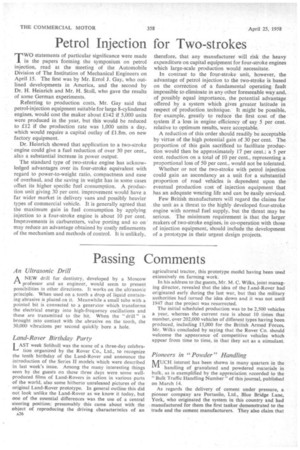Petrol Injection for Two-strokes
Page 28

If you've noticed an error in this article please click here to report it so we can fix it.
TWO statements of particular significance were made in the papers forming the symposium on petrol injection, read at the meeting of the Automobile Division of The Institution of Mechanical Engineers on April 15. The first was by Mr. Errol J. Gay, who outlined developments in America, and the second by Dr. H. Heinrich and Mr. H. Stoll, who gave the results of some German experiments.
Referring to production costs, Mr. Gay said that petrol-injection equipment suitable for large 8-cylindered engines, would cost the maker about £142 if 5,000 units were produced in the year, but this would be reduced to £12 if the production rate was 1,000 units a day, which would require a capital outlay of £1.8m. on new factory equipment.
Dr. Heinrich showed that application to a two-stroke ' engine could give a fuel reduction of over 30 per cent., also a substantial increase in power output.
The standard type of two-stroke engine has acknowledged advantages over its four-stroke equivalent with regard to power-to-weight ratio, compactness and ease of overhaul, and the saving in weight has in some cases offset its higher specific fuel consumption. A production unit giving 30 per cent. improvement would have a far wider market in delivery vans and possibly heavier types of commercial vehicle. It is generally agreed that the maximum gain in fuel consumption by applying injection to a four-stroke engine is about 10 per cent. Improvements in carburetters, valve porting and so on may reduce an advantage obtained by costly refinements of the mechanism and methods of control. It is unlikely, therefore, that any manufacturer will risk the heavy expenditure on capital equipment for four-stroke engines which large-scale production would necessitate.
In contrast to the four-stroke unit, however, the advantage of petrol injection to the two-stroke is based on the correction of a fundamental operating fault impossible to eliminate in any other foreseeable way and, of possibly equal importance, the potential advantage offered by a system which gives greater latitude in respect of production technique. It might be possible, for example, greatly to reduce the first cost of the system if a loss in engine efficiency of say 5 per cent. relative to optimum results, were acceptable.
A reduction of this order should readily be acceptable by virtue of the high potential gain of 30 per cent. The proportion of this gain sacrificed to facilitate production would then be approximately 17 per cent.; a 5 per cent. reduction on a total of 10 per cent., representing a proportional loss of 50 per cent., would not be tolerated.
Whether or not the two-stroke with petrol injection could gain an ascendancy as a unit for a substantial proportion of road vehicles is dependent upon the eventual production cost of injection equipment that has an adequate wearing life and can be easily serviced.
Few British manufacturers will regard the claims for the unit as a threat to the highly developed four-stroke engine with normal fuel supply, but the threat may be serious. The minimum requirement is that the larger makers of two-stroke engines, in co-operation with those of injection equipment, should include the development of a prototype in their urgent design projects.




































































































